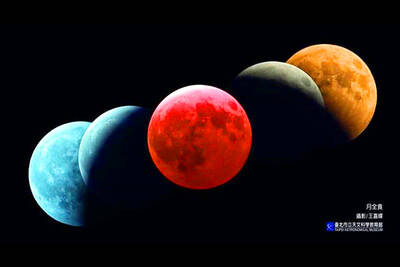Nearly half of the nation’s mentally ill patients do not take their prescribed treatment, according to a recent survey released on Friday ahead of yesterday’s International Day of Persons with Disabilities.
About 45 percent of the caregivers of mentally ill patients said the patients would either hide their medication or throw it away, according to the Alliance for the Mentally Ill, which conducted the survey.
“There are several reasons why mentally ill people do not like to take medication,” said Jewel Chen (陳萱佳), deputy secretary of the association.
“Some patients dislike the side-effects of the drugs, some believe that they have fully recovered and others are not aware of their mental condition,” Chen added.
There are cases in which the caregiver has to grind the drug into powder form and add it to the patient’s food or drinks, she said.
More than 40 percent of the respondents said quarrels sometimes arise over the patients’ medication.
Huang Min-wei (黃敏偉), a doctor specializing in schizophrenia, said it is important to take prescribed drugs on time in order to control the symptoms of mental illness.
Relapses could lead to more damage, and the chances of relapse are about five times higher if the medication is discontinued without the doctor’s consent, he warned.
The survey was conducted in September among 198 caretakers of mentally ill patients. Most of the caretakers were parents, spouses or children of the patients.

Three batches of banana sauce imported from the Philippines were intercepted at the border after they were found to contain the banned industrial dye Orange G, the Food and Drug Administration (FDA) said yesterday. From today through Sept. 2 next year, all seasoning sauces from the Philippines are to be subject to the FDA’s strictest border inspection, meaning 100 percent testing for illegal dyes before entry is allowed, it said in a statement. Orange G is an industrial coloring agent that is not permitted for food use in Taiwan or internationally, said Cheng Wei-chih (鄭維智), head of the FDA’s Northern Center for

LOOKING NORTH: The base would enhance the military’s awareness of activities in the Bashi Channel, which China Coast Guard ships have been frequenting, an expert said The Philippine Navy on Thursday last week inaugurated a forward operating base in the country’s northern most province of Batanes, which at 185km from Taiwan would be strategically important in a military conflict in the Taiwan Strait. The Philippine Daily Inquirer quoted Northern Luzon Command Commander Lieutenant General Fernyl Buca as saying that the base in Mahatao would bolster the country’s northern defenses and response capabilities. The base is also a response to the “irregular presence this month of armed” of China Coast Guard vessels frequenting the Bashi Channel in the Luzon Strait just south of Taiwan, the paper reported, citing a

UNDER PRESSURE: The report cited numerous events that have happened this year to show increased coercion from China, such as military drills and legal threats The Chinese Communist Party (CCP) aims to reinforce its “one China” principle and the idea that Taiwan belongs to the People’s Republic of China by hosting celebratory events this year for the 80th anniversary of the end of World War II, the “retrocession” of Taiwan and the establishment of the UN, the Mainland Affairs Council (MAC) said in its latest report to the Legislative Yuan. Taking advantage of the significant anniversaries, Chinese officials are attempting to assert China’s sovereignty over Taiwan through interviews with international news media and cross-strait exchange events, the report said. Beijing intends to reinforce its “one China” principle

A total lunar eclipse, an astronomical event often referred to as a “blood moon,” would be visible to sky watchers in Taiwan starting just before midnight on Sunday night, the Taipei Astronomical Museum said. The phenomenon is also called “blood moon” due to the reddish-orange hue it takes on as the Earth passes directly between the sun and the moon, completely blocking direct sunlight from reaching the lunar surface. The only light is refracted by the Earth’s atmosphere, and its red wavelengths are bent toward the moon, illuminating it in a dramatic crimson light. Describing the event as the most important astronomical phenomenon